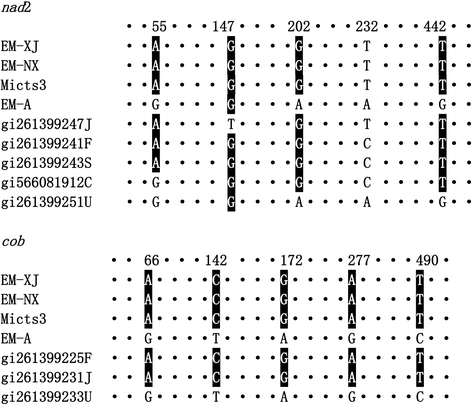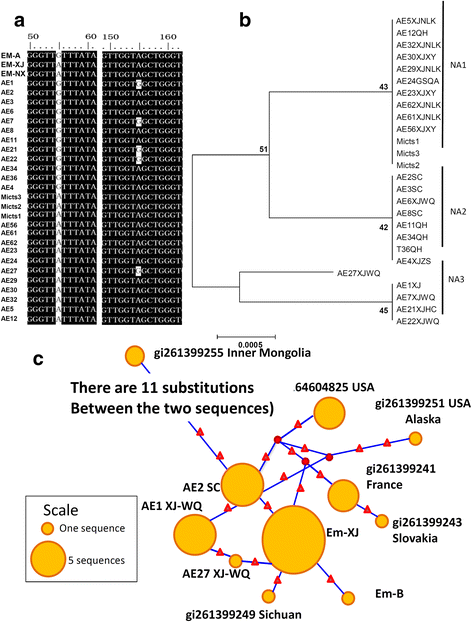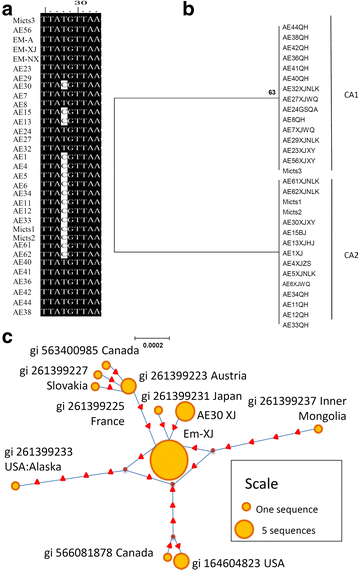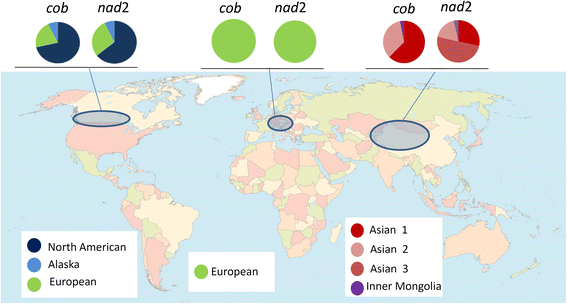Genetic variation of mitochondrial genes among Echinococcus multilocularis isolates collected in western China
- PMID: 28558809
- PMCID: PMC5450100
- DOI: 10.1186/s13071-017-2172-y
Genetic variation of mitochondrial genes among Echinococcus multilocularis isolates collected in western China
Abstract
Background: Alveolar echinococcosis (AE) is a life-threatening human disease caused by Echinococcus multilocularis transmitted between rodents and dogs/foxes in the Northern Hemisphere. The study aims to identify the genetic variation of the parasite in AE patients from China.
Methods: E. multilocularis isolates were collected from wild small mammals (n = 6) and AE patients (n = 56) from western China. Genomic DNA was extracted from different tissue samples including paraffin tissue blocks, ethanol fixed tissues and frozen tissues surgically removed. Two mitochondrial gene fragments (526 bp for cob and 474 bp for nad2) of E. multilocularis were amplified and sequenced.
Results: The parasite fragment sequences of cob fragments from AE patients showed two haplotypes, and nad2 gene fragment sequences had four haplotypes. The gene sequences from Microtus sp. were 100% identical to the sequences of some isolates from AE patients. These haplotypes were distributed in both Qinghai and Xinjiang provinces. Alignment analysis with the sequences from the GenBank databases showed five genotypes including three Asian genotypes, one from Europe and one from North America.
Conclusions: Most AE patients harbored the Asian genotype 1 which may be an indication of its relative frequency in the definitive hosts and the environment or of its pathogenicity to humans, which calls for further research.
Keywords: Alveolar echinococcosis; Echinococcus multilocularis; Genetic variation; Mitochondrial genes; cob; nad2.
Figures




Similar articles
-
Genetic diversity of Echinococcus multilocularis and Echinococcus granulosus sensu lato in Kyrgyzstan: The A2 haplotype of E. multilocularis is the predominant variant infecting humans.PLoS Negl Trop Dis. 2020 May 13;14(5):e0008242. doi: 10.1371/journal.pntd.0008242. eCollection 2020 May. PLoS Negl Trop Dis. 2020. PMID: 32401754 Free PMC article.
-
Morphological and molecular characteristics of Echinococcus multilocularis and Echinococcus granulosus mixed infection in a dog from Xinjiang, China.Vet Parasitol. 2006 Jun 30;139(1-3):244-8. doi: 10.1016/j.vetpar.2006.03.003. Epub 2006 Apr 17. Vet Parasitol. 2006. PMID: 16616990
-
Investigation and genetic polymorphism analysis of rodents infected with Echinococcus in Ili Prefecture, Xinjiang Uygur Autonomous Region, China.Front Cell Infect Microbiol. 2024 Aug 9;14:1433359. doi: 10.3389/fcimb.2024.1433359. eCollection 2024. Front Cell Infect Microbiol. 2024. PMID: 39185087 Free PMC article.
-
Assessment of the global pattern of genetic diversity in Echinococcus multilocularis inferred by mitochondrial DNA sequences.Vet Parasitol. 2018 Oct 15;262:30-41. doi: 10.1016/j.vetpar.2018.09.013. Epub 2018 Sep 27. Vet Parasitol. 2018. PMID: 30389009 Review.
-
On the geographic genetic variants of the cestode Echinococcus multilocularis with reference to the original descriptions from Bowles et al. (1992) and Bowles and McManus (1993), and their use.Parasitol Int. 2020 Apr;75:102039. doi: 10.1016/j.parint.2019.102039. Epub 2019 Dec 13. Parasitol Int. 2020. PMID: 31843686 Review.
Cited by
-
Canine Alveolar Echinococcosis: An Emerging and Costly Introduced Problem in North America.Transbound Emerg Dis. 2023 Feb 21;2023:5224160. doi: 10.1155/2023/5224160. eCollection 2023. Transbound Emerg Dis. 2023. PMID: 40303731 Free PMC article.
-
Genetic diversity of Echinococcus spp. in wild carnivorous animals in Kazakhstan.Vet World. 2022 Jun;15(6):1489-1496. doi: 10.14202/vetworld.2022.1489-1496. Epub 2022 Jun 15. Vet World. 2022. PMID: 35993082 Free PMC article.
-
Occurrence and genetic characterization of Echinococcus granulosus sensu lato from domestic animals in Central Iran.BMC Vet Res. 2022 Jan 7;18(1):22. doi: 10.1186/s12917-021-03131-1. BMC Vet Res. 2022. PMID: 34996460 Free PMC article.
-
A Case Series and Literature Review of Alveolar Echinococcosis in Kashmir, India: An Emerging Endemic Zone for Echinococcus multilocularis.Life (Basel). 2024 Jun 24;14(7):794. doi: 10.3390/life14070794. Life (Basel). 2024. PMID: 39063549 Free PMC article.
-
The Molecular Epidemiology of Echinococcus Infections.Pathogens. 2020 Jun 8;9(6):453. doi: 10.3390/pathogens9060453. Pathogens. 2020. PMID: 32521787 Free PMC article. Review.
References
-
- McManus DP, Gray DJ, Zhang W, Yang Y. Diagnosis, treatment, and management of echinococcosis. BMJ. 2012;344:e3866:e3866. - PubMed
-
- Afonso E, Knapp J, Tete N, Umhang G, Rieffel D, van Kesteren F, et al. Echinococcus multilocularis in Kyrgyzstan: similarity in the Asian EmsB genotypic profiles from village populations of Eastern mole voles (Ellobius tancrei) and dogs in the Alay valley. J Helminthol. 2015;89(6):664–670. doi: 10.1017/S0022149X15000474. - DOI - PMC - PubMed
MeSH terms
Substances
LinkOut - more resources
Full Text Sources
Other Literature Sources

